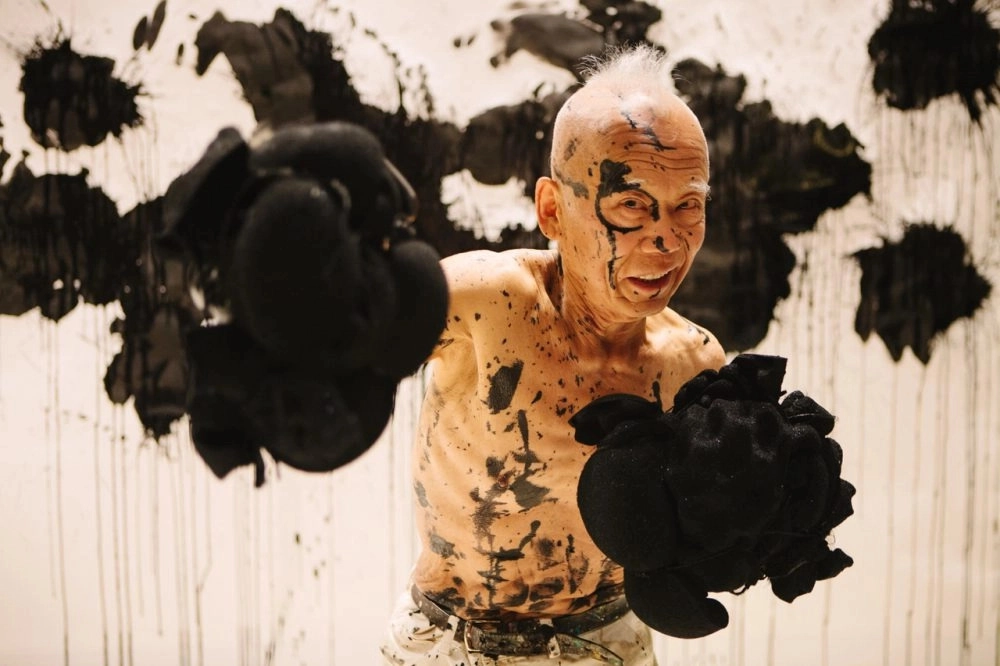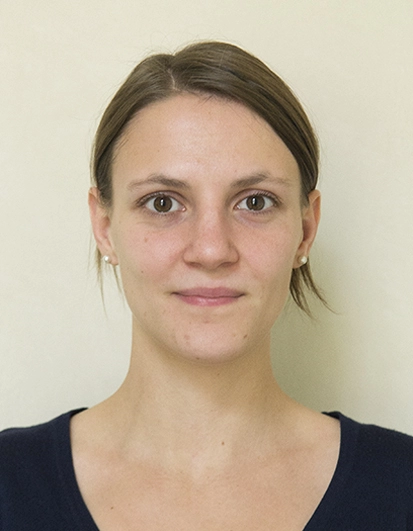„Beginning at the far right, throwing first a black-dipped right and then a neon-pink left, he weaves along the canvas, landing jabs and swipes that become large vivid “brushstrokes.”.Approaching the end, he lags momentarily. But regains his wind long enough to finish off the last blows and complete his newest work.“ This is one of the many famous art performances by Japanese artist Ushio Shinohara. The so-called “boxing painting” is one of his characteristic and undoubtedly most famous art expressions.

The ninety-one-year-old Japanese artist, also known as Gyu-chan, creates his large-scale works by boxing with the canvas. For this interactive painting style, he is equipped with swimming goggles, stripped to his midriff and wearing boxing gloves with sponges attached that he dips in paint. The imprints of the gloves and the paint running down the canvas create visually impressive rain clouds. The artist often makes public appearances, inviting viewers into his studio or exhibition gallery to watch his work. This unusual experience also takes place in front of a large audience from time to time.

Similar to the French representative of lyrical abstraction Georges Mathieu, Ushio Shinohara is interested in the speed of execution which does not allow the artist to think about his work. Shinohara's "boxing paintings" are based on the motto "fast, beautiful and rhythmical". Mathieu, who held the view that a painter must not rely on any reference and no move must be premeditated, also painted his large-scale canvases in front of an audience. It was the style of this artist who toured Japan in 1957 that Shinohara was certainly influenced by.

Shinohara himself claims that when he’s working he doesn’t think about anything. „I set aside all of the art techniques and habits I’ve developed over the years and start punching away with no time to stop and think. That brings out the aesthetic sense in my core.“
Similarly to Mathieu, his works are partially controlled and partially subject to automatic drawing. „I’m always saying that I’m responsible only for 50 % of my work. People can view my work any way they want. So they are responsible for the remaining 50 %,“ he quips and adds: „If you have the intention of making a good painting, you cannot make one that is truly good. That’s why I quickly throw punches, before my mind can catch up with me.“

Shinohara's work is often linked to the American abstract expressionists Jackson Pollock and Mark Rothko. The artist himself was attracted to America and decided to move there in the late 1960s. Unlike the artists mentioned above, however, Shinohara interpreted action painting as a sport, creating his own unique brand. According to art historian Reiko Tomio, it is this fact that sets Shinohara apart from other artists. According to her, he “pioneered the ephemeral art form of using physical action to create paintings“
Ushio Shinohara began with action painting in the 1960s. He created his first boxing painting in 1960. Boxing was very popular in Japan at the time and was featured in the then-popular Nikkatsu action films. All of this may have served as another source of inspiration for the artist's early work.
.jpg)
With his head shaved at the sides into a mohawk and his affinity for action art, he was considered the enfant terrible of the Tokyo avant-garde art scene of the late 1950s and was hailed as a representative of the Japanese new wave. Shinohara's seemingly unfinished pieces, frayed canvases and unframed pictures led him to be categorised as a neo-Dada. "When he would assault his early canvases with not only his boxing gloves but his body and head as well, his stylised hair became a sort of calligraphic brush.."
Shinohara's first works are captured in photographs taken by the famous American photographer and filmmaker William Klein in the spring of 1961. These photographs of contemporary Tokyo were then published in the 1964 collection titled Tokyo. William Klein also photographed Shinohara's later work, for example in 2012 in New York.

In 1969, Ushio Shinohara moved to New York and began to pursue other artistic expressions. His efforts to establish himself here were much less successful than in Japan, and the artist soon started to struggle financially. He didn't return to his boxing painting until 1991, and even today, at his advanced age, he is still keeping in shape. As a result, for example, during a live performance at the opening of his Tokyo exhibition in 2022, he was able to paint two large-scale canvases 10 metres wide together in just about 10 minutes. The artist was also the subject of a documentary called Cutie and the Boxer, focusing on his life with his wife and artist Noriko, which was nominated for an Oscar in 2014.
Ushio Shinohara was born in Tokyo in 1932. He studied Yōga (Western-style painting) at the Tokyo Academy of Art but did not graduate. In 1955 he participated in the independent exhibition Yomiuri, which brought him into the public eye for the first time. He later joined the Neo-Dadaism Organizers, a Japanese group founded in 1960, which, despite its short duration, brought about significant changes in the Japanese art scene. In 1969, Ushio Shinohara was awarded a scholarship that allowed him to spend a year in the United States, where he eventually stayed permanently. His works have been exhibited in many museums around the world, including MoMA and The Metropolitan Museum of Art. He lives and works in New York.
Boxing is fascinating not only for Ushio Shinohara but also for several Czech artists. Check out the new curator's collection in our gallery.





